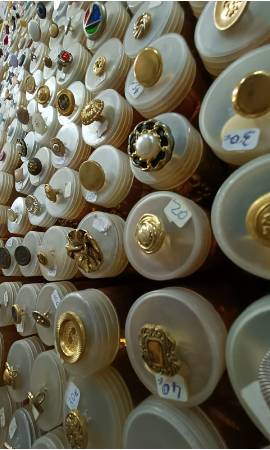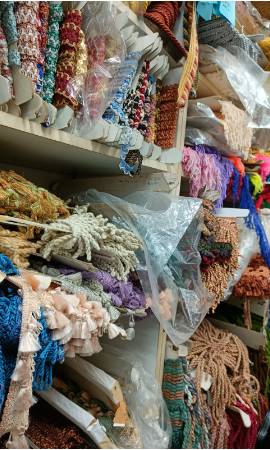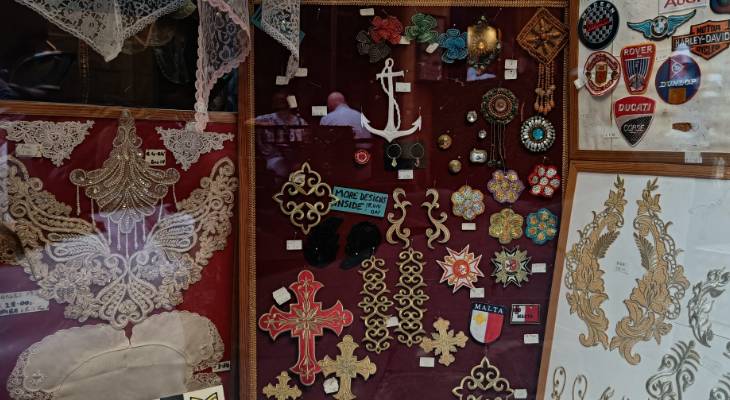Walking the charming streets of Valletta has its perks. And, while walking up and down the stairs is definitely a workout, one can note that the traditional colourful boutique shops have slowly have faded away from Malta's capital.
WhosWho.mt recently explored the streets of Valletta and met up with Pierre Galea, one half of the Galea brothers’ administration, that took over the Victor Galea Haberdashery nestled between the upper and lower Barrakka Gardens on St Paul’s Street.
With a six-decade long history, the Victor Galea Haberdashery store has witnessed a transformation in Malta’s sewing scene. From a thriving clientele in the 80s to a more challenging present, where they are winning over a younger generation.
Pierre told WhosWho.mt that the family haberdashery store opened in 1955 by their grandfather. But the shop utilised at the time was not the same vibrant blue shop that is renown nowadays. In fact, the original store was just a few meters away from their present location, which is now used as a store for their stock. “This shop opened the market for haberdasheries in Malta,” Pierre said.
He remarked that his brothers, himself and his father were brought up in this business. His father took over the business at the age of 15 and opened the shop that is in use today, and the rest is history.
“Me and my two brothers took over the business around 20 years ago and back then we had a lot of business. This changed a lot, especially the way people buy clothes,” Pierre says. Eventually, one of the brothers opted out of the business and now Eric and Pierre took over, operating the Valletta shop and their other outlet in Paola. Nonetheless, their faither Victor, still contributes to the business and frequently bags crafting items for them to sell and make their lives easier.

Hundreds of buttons with different styles and materials found inside the store
Despite facing changing consumer habits and economic challenges, the shop remains a haven for artisans and craft enthusiasts, housing an array of lace, ribbons, buttons, craft tools, and knitting supplies.
“We’ve had a period where the business was not doing well at all. At the end of the day we are heavily dependent on the elderly who live in Valletta, who still mend their clothes if torn and not instantly thrown away. But then again, even residents are diminishing in Valletta,” Pierre remarks.
Attracting tourists more than locals and gaining traction during COVID
Pierre explains that the nowadays, the business attracts more tourists than locals. He explains that the haberdashery shop, to this day, still has items that are specifically sought after by many locals visiting the shop. On the other hand, showed WhosWho.mt a small container of ‘madreperla’ buttons that are extremely sought after by tourists.
“Every day we have multiple tourists that come up to the shop just to take a look around. For the older generation in Malta, such haberdashery stores were a common sight in the past, but for tourists not so much. Sometimes tourists come inside just to take photos, we’re almost like a museum or a landmark,” Pierre says with a smile to his face.
Funnily enough and despite the decrease in demand, he says that during COVID-19, they made a lot of deliveries around Malta for crochet and knitting supplies. Asked about his best-selling items, he was quick to point out that crafting items such as beads, are always very popular.
‘Nowadays people don’t always have the time to sew their own clothes’
Pierre says that nowadays people might not have the time to sew their own clothes or spend time looking for the right material for a dress. “People might find it easier to scroll on the internet. And dresses back then were not cheap to buy, so that is another reason as to why people preferred to make their own clothes at the time. Now many prefer cheaper clothes from the internet rather than spending a lot of money on one dress.”
Despite changing times and the convenience of online shopping, Pierre remains committed to supporting local businesses. He encourages shoppers to explore their local options before turning to international retailers, emphasising that it's essential to nurture one's own country's economy.

Materials of every colour and shape, sourced from various countries
‘When certain materials doubled in price, we had no choice but to reduce profit. We couldn’t risk losing clients’
Showing WhosWho.mt some of the materials sold in small bulk, he stated that the shop is extremely popular with carnival costume designers. The sales made on this occasion remained a constant for the business and so do certain materials used for pavilions (pavaljuni). However it comes with a price.
Sourcing the best materials is important for the business and some are sourced directly from England, Italy and Turkey. “However, we had an issue with inflation. The same material that we’ve bought repeatedly for the past 20 years has recently doubled in price. We cannot increase the prices exponentially to cover the additional money we had to pay, or else we risked losing clients.”

The display of the shop in St John's Street
He continues to explain that the shop manages to sell a lot of materials for pavilions. These materials have also become increasingly expensive.
“It is not easy in our situation; we had no choice but to cut our profit. Me and my brother still work in our shop because of our passion. I’m sure that if I had to have another job, I would have a much larger income. But at the end of the day, we’ve been here for many years,” he says.
Pierre concluded, that although the future is still uncertain and running a business is not always smooth sailing, they are “very passionate about the shop. To this day, many people tell us not to close our shops.”
Main Image:
